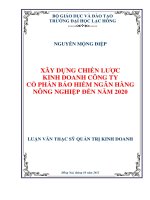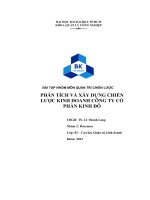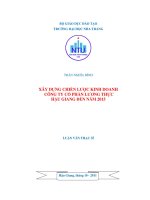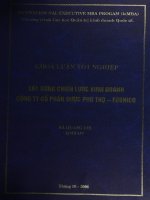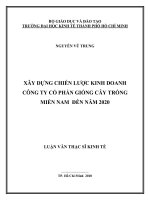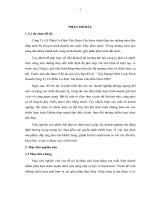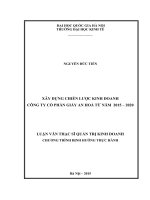Luận văn xây dựng chiến lược kinh doanh công ty cổ phần địa ốc TASCO
Bạn đang xem bản rút gọn của tài liệu. Xem và tải ngay bản đầy đủ của tài liệu tại đây (4.84 MB, 75 trang )
LUẬN VĂN THẠC SĨ MBA
Xây dựng chiến lược kinh doanh công ty cổ phần địa ốc TASCO
THESIS TOPIC
BUILDING REAL ESTATE BUSINESS STRATEGY FOR
TASCO JONT STOCK COMPANY
Page 1
TABLE OF CONTENTS
TT
CONTENTS
Pages
Acknowledgements
Table of contents
List of table
List of Figures, Graphs
1
2
3
4
5
1.1
1.2
1.3
1.3.1
1.3.2
1.4
1.4.1
1.4.2
1.4.3
1.4.4
1.4.5
1.5
1.5.1
1.5.2
INTRODUCTION
The necessity of research topic
Research purposes
Object and scope of research
Research Methodology
Layout thesis
Chapter 1 : BASIS THEORY OF STRATEGY
Concept of Strategy
Role of strategic
Types of strategic
By the level of strategic management
Dividing strategic by functions
Building strategies process
Mission and objectives of the enterprise
Analyze and evaluate external environment
Analysis and assessment Internal environmental
Matrix Internal - External (Matrix IE)
Analyzing strengths weaknesses of the business ( SWOT)
Selection strategy
Selection criteria
Method of selection strategies
Chapter 2: ANALYSIS REAL ESTATE BUSINESS ENVIRONMENTAL OF
TASCO JOINT STOCK COMPANY
2.1
2.1.1
2.1.2
2.1.3
2.2
2.2.1
2.2.2
2.3
2.4
2.5
2.6
Introduction
TASCO Joint Stock Company
Business Activities
History and development, Important timeline
External environment analysis
Macro Environment
Micro environment
External Factors environmental Matrix
Analysis Internal environment
Internal Factors environmental Matrix
Internal – External Enviroment Matrix of TASCO – IE Matrix
Chapter 3 : BUILDING REAL ESTATE BUSINESS
1
1
3
3
3
3
3
3
3
4
4
4
6
8
8
9
16
18
19
19
19
20
20
20
20
20
22
22
33
45
56
57
59
Page 2
STRATEGY OF TASCO JOINT STOCK COPANY
3.1
3.2
3.3
3.4
3.4.1
3.4.2
3.4.3
3.4.4
3.4.5
3.4.6
3.5
3.6
3.6.1
3.6.2
3.6.3
3.6.4
3.6.5
3.7
3.8
3.9
Oriented development
Objective of TASCO Jsc
Predition of Real Estate Market
Building strategies
Differenlize products Strategy
Market development Strategic
Enhance competitiveness Strategic
Vertical integration Strategic
Diversifying business Strategy
Joint venture Strategic
Chosing Real estate business Strategies for TASCO Jsc
Implementation Solutions
Solution structure of the Organization
Marketing solutions
Solutions to build and develop brands
Human Resource Solutions
Financial solutions
Roadmap for implementation of strategies to 2020
Reviews and Checking the Strategy
Recomendation
CONCLUSION
59
60
60
66
69
69
69
70
70
71
71
72
72
73
74
75
76
77
79
79
82
Page 3
LIST OF TABLES
No
1
2
3
4
5
6
7
8
Name
Table 1-3
Table 1-5
Table 1-9
Table 2-3
Contents
Model building EFE Matrix
Model building IFE Matrix
QSPM–Quantitative Strategic Planing matrix
Statistics of the number of hotels and
Pages
13
16
19
37
Table 2-4
Table 2-5
Table 2-6
accommodation Hanoi City.
Competition Matrix
External Factors Environmental Matrix of TASCO.
Total of the opportunities and Threats affecting
42
43
44
Table 2-7
the business activities of TASCO:
Balance sheet of TASCO Joint stock
46
Company
9
10
11
12
13
14
15
16
17
Table 2-8
Table 2-9
Table 2-12
Income statement of TASCO
Expenditure analysis of Financial
Internal Factors environmental Matrix of TASCO –
47
47
56
Table 2-13
Table 2-14
Table 3-1
IFE Matrix
General strengths and weaknesses of TASCO
IE Matrix of TASCO
Housing demand Prediction in the city, 2010-
57
58
63
Table 3-2
Table 3-3
Table 3-4
2025
Demand for offices in Hanoi, 2010-2025
Forecast demand for hotels in Hanoi, 2010-2025
Prediction demand for the number of hotel
64
65
66
rooms
18
19
Table 3-5
Table 3-6
Synthesis of SWOT Matrix elements
Scoring criteria of the Real estate business
67
71
Strategy
LIST OF FIGURES, GRAPHS
No
Name
Contents
Pages
Page 4
1
2
3
4
5
6
7
8
9
10
11
12
Figure 1-1
Figure 1-2
Figure 1-4
Figure 1-6
Figure 1–7
Figure 1–8
Figure 2-1
Figure 2-2
Figure 2-10
Figure 2-11
Figure 3-7
Figure 3-8
Model of strategic management comprehensive DAVID F.
Models of competitive work force by Michael Porter
The process of building EFE Matrix
Map Process of building a matrix IFE
Model of IE Matrix
Model SWOT Matrix
Value of GDP of Hanoi through the years.
Economic structure of Hanoi in 2008
Organization Chart of TASCO
Drawings overall perspective Xuan Phuong New Urban
Models identified Values of the development in TASCO
Roadmap for implementation of strategies from 2009 to
2020 of TASCO
INTRODUCTION
1. The necessity of research Topics:
Vietnam joined the World Trade Organization (WTO), the trend of globalization as
today, the business is facing great opportunities to build and develop to a new level
and also for with the
big potential threaten. To survive and develope, businesses need to build for
themselves the direction and strategies of business on the basis of relevant research, analysis, business
Page 5
7
11
14
16
17
18
23
24
54
55
72
78
environment and the external environment within their own to take advantage of opportunities, minimize
risks from the business environment, as well as promoting the strengths and limited weaknesses of
companies.
Derived from practice that the
building business strategy is very necessary for every business. It
helps business-oriented, clear business objectives, user parts and individuals to overall business objectives,
prevent the local, distributed resources will weaken the business. Today's business environment is rapidly
changing, competitive global business always requires active and creative to adapt to the change.
Real estate business is a very particular, require special conditions such as strong
financial resources, ability to mobilize capital, relationships with agencies
specialized management functions, orientation as well as long-term vision of
business leaders.
Real estate business is cycle activities, so the risk is great, but comes with big risk is
very attractive profit so business is increasingly attracting businesses to participate.
Vietnam in general and
The capital Hanoi in particular are on the rise rapidly, the demand of the
product properties such as houses, office buildings, commercial centers, hotels ... very large, this is also the
opportunity and challenge for the Real estate enterprises.
2. Research purposes:
Systematics on the basis of theoretical premises strategies for analyzing the factors
affecting the operations of the company, develop strategies.
Analysis of factors affecting the business environment of real estate, business and
production operations of the company from which combined with the orientation
and objectives of the TASCO jont stock Company to build real estate
business strategies.
3. Object and scope of research:
TASCO
Joint stock Company is a company that has business on real estate established and operated
mainly in Hanoi Capital . Therefore content to go further research, The authors would focus on analyzing the
business environment by TASCO is primarily the business environment in Hanoi Capital to build real estate
business strategic of the Company from now to year 2020.
Due to limited time and duration of study, although the field of business activity
around Tasco very diverse skilled construction and installation is only the authors of
selected real estate business and limited geographical analysis is in the capital
Hanoi. This is a market-oriented of the father company when TASCO complete
activities in the model company. This market is dynamic, challenging but full of
potential.
Page 6
4. Research Methodology:
Research methods: the information gathered from books, newspapers, magazines,
the statistics of Ha noi Statistics Department,
information and statistics from the consulting firm of real
estate business. Internal sources of information are the balance sheet, reporting the results of production and
business operations, financial reporting in 2007, 2008 – The time to December, 2009.
Also
Authors also uses analytical methods integrated, comparative approach, methods experts to analyze
the situation of production and business operations of Company.
5. Layout thesis: Thesis is structured as follows:
Introduction.
Chapter 1: Basic Theory
of strategic .
Chapter 2: Analyzing The real estate
business environment of the TASCO joint stock Company.
Chapter 3: Building and Selection Real estate business Strategy of TASCO joint stock Company.
Conclusion.
Page 7
CHAPTER 1
BASIS THEORY OF STRATEGY
1.1. Concept of Strategy:
Strategy is a general program of action to achieve specific objectives. Speaking to a
strategic organization that people often think it must be held to determine the
objectives to reach what, how and how to make sure that the resources for it.
Afred Chandler definition: Strategy encompasses assign the basic long-term goals of an organization,
and selection process or how to act and allocate resources necessary to implement the goals .
According FERD R, David in the "Treatise on management strategy”: The strategy is the means
of the long-term goals. Business strategy may include the development of geographical diversification of
activities, chemical property, product development, market access, cut spending, liquidation and joint
ventures.
Strategy is also understood as a set of goals and policies as well as plans to achieve
the main goal, it shows that business going to make what business and enterprise or
will be subject to any business.
1.2.Role of strategy:
1.2.1.Planning:
Business strategy to help companies find clear purpose and direction to his. It's just the
administrator must consider and that is determine the direction of organizing to do and always will achieve
desired results.
1.2.2.Forecasting:
In a constantly fluctuating environment, the opportunities and risks always appear.
Process of strategic planning helps managers to analyze the environment and make predictions to identify
strategies accordingly. Whereby administrators are better able to grasp opportunities, take advantage of
opportunities and reduce risks related to the environment.
1.2.3.Controlling: Strategic helps administrators to use and allocation of resources is optimal as well as to
coordinate effectively function within the organization to achieve a common goal threads out.
1.3.Types of Strategy
Page 8
1.3.1. By The level of strategic management
Based on level of management strategies that strategy is divided into three groups
below:
1.3.1.1. Strategies for companies:
Strategy for the company and outlined clearly defined purpose and objectives of the
company, identifying the business that the company pursue, create policies and
plans to achieve the basic objectives of companies, distribution of resources among
business activities. Strategy applies to the entire enterprise.
1.3.1.2.The level business strategy :
Strategic level business planning is to determine the selection of specific products
or as the market for private business activities within the company. Level business
strategy, one must determine how each business unit must be completed to
contribute to accomplishing the goal for the company.
1.3.1.3. Functionality strategy:
Strategy for functional people focus on supporting the company strategy and focus
on areas of industrial cooperation, the business sector.
1.3.2. Dividing strategies by functions
Pursuant to the strategic functions that can be divided into the following groups:
1.3.2.1. Combination strategies:
Group strategy is the strategy combination of front, rear and combined combined
horizontally.
- Combining forward: implementing enterprise increase in control or ownership to
the distributors or retailers.
- Combination rear: company made up ownership or control over suppliers. This
will allow businesses to provide stability, control input costs.
- Combination horizontal: businesses want to control the competition. This strategy
allows
centralized
resources,
expanding
activities
and
increasing
the
competitiveness of enterprises.
1.3.2.2. Specialize strategies:
Page 9
This group have strategies such as market entry strategies, strategic market
development and strategic product development
- Market Entry Strategies: to increase market share for products or services available in the market's
current business.
- Market Development Strategies: into the new regional products or services existing business.
- Product development Strategies : take the current market products or services similar to existing products
of these enterprises has improved modified.
1.3.2.3.Strategies to expand operations :
The strategic expansion activities include strategies to diversify the activities center,
diversify activities and horizontally diversified operations activities mixed.
-
Diversify the activities center: bring to market existing products or new services related to existing
products.
- Diversify the horizontal activities: put on the market for existing customer groups
present products or new services, not related to the products are.
- Diversifying operations mixture: put on the market in existing products or new
services, not related to the products are.
1.3.2.4.Other strategies:
In addition to the above strategy, the reality is there are some other strategies that
businesses can apply as a joint venture strategy, refine operations, quit operation,
liquidation, etc.
- Strategy venture: when one or more businesses link together to pursue a certain
goal.
- Strategy to narrow it works: when enterprises need to restructure, ttu carried out a number of products or
fields
of
activity
to
save
Left
position
of
the
business.
- Strategy for liquidation: is the sale of assets to the enterprise. Business accept defeat and try to rescue
picked up what they can.
1.4. Building strategies recuitment:
Strategic management process described by The model summarized below:
Page 10
Implement
controls to
identify
external
opportunities
and threats
directly
Identify
tasks and
strategic
objectives
current
Establish
long-term
goals
Measurem-
Review
business
objectives
Implement
internal
controls to
find the
strengths,
weaknesses
Set annual
goals
-ent and
evaluation
results
Distribution
of resources
Selection
strategies to
pursue
Building
Forth
policies
Implementation
Rank
strategic
strategic
strategic
Figure 1-1: Model of strategic management comprehensive DAVID F.
1.4.1. Mission and objectives of the enterprise
Mission is a statement with the nature of long-term goals. It distinguishes this
business with other enterprises. The declaration also so-called speech of a business
Page 11
to business philosophy, principles of business, the trust company. All of which
determine the region's business enterprises, in particular products, basic services,
the fundamental group of customers, market demand, technical field or a
combination of domains this area. Mission contains a general wish to declare the
area outside the company as a public image that businesses wish.
The company's mission should be deployed and sketches into specific target.
Objective is defined as the achievements and results that administrators want to
achieve in the future for your organization.
1.4.2. Analyze and evaluate external environment
External environmental analysis focused on identifying and assessing trends with
events beyond the control of the company, such as growth of national economy, the
competition abroad, explosion of information technology ... will see the opportunity
and the risk that an important experience to the organization managers can draft
strategy to take advantage of the opportunities and avoid or degrading images
effects
of such threats. External environment including the macro environment and micro environment.
1.4.2.1. Macro environment:
Analyzing the macro environment to help businesses answer to the question:
Companies are faced with/to what?
a/Economic factors
Economic factors have a direct impact to the attraction potential of different
strategies.
The influence of economic factors such as economic growth, inflation, economic cycle, the
increase or decrease interest rates, stock price, the trend of the value of the U.S. dollar, the tax system and tax
rates; etc. ...
b/Legal and political factors
Factors law and political influence to the growing activities of the enterprise.
Factors, including legal institutions, policies, regulations, institutions, laws,
treatment regimes, procedures, regulations, ... the State. In some countries also have
to mention the level of political stability or sustainability of the government. Laws
and state agencies along with pressure groups have roles to regulate the business.
c/Social factors
Page 12
All enterprises must analyze a wide range of social factors to assign opportunities,
potential threats. These factors include social factors such as women, demographic
pressures, lifestyle, ethics, traditions, practices, rates of population growth,
population shift, level of position
etc ... Changes in geographic, demographic, cultural and social
influences important to almost all decisions about products, services, markets and consumers.
d/Natural elements
These businesses have long recognized the impact of natural circumstances in their business decisions.
Analysis of natural elements including the consideration to issues of environmental pollution, energy
increasingly scarce natural resources, mineral exploitation and indiscriminate quality natural environment
risk of degradation, etc ... In addition, administrators must be aware of cases of force majeure such as natural
disasters, storms, floods and painting services ... to reserve the countermeasures in the process of production
activities their business.
e/Technology and technical factors
For businesses, technologies or other factors related to technology such as R & D,
copyright and technology, automation trends, technology transfer, ... can be both an
oppotinities, just the threat that they must be properly considered in drafting the strategy. Due to rapid
technological change also means shorten the life cycle or life cycle of products is required. New technologies
also bring the process of new technologies to help reduce costs significantly in product price. Technical
progress can create new competitive advantages, strong advantages over the existing.
f/International factors
Trend of globalization, economic integration and liberalization of international trade
is the prominent problems of the world economy today. The rules and regulations
agreed by the members of the general European Community, World Bank, World
Trade Organization (WTO) agreements free trade area an d
the world, the conference ,
economic summit has contributed to the interdependence between countries around the world and the global
market generally appears, set international standards on product quality and standards on environmental
pollution, the antitrust laws, anti-dumping ... The strategist must take advantage of the advantages that the
trend of globalization and international economic integration offers, and restrict the risks from the
international environment, there is a fierce competition of foreign rivals, with products at competitive prices
and better quality..
1.4.2.2. Micro environment:
This is a working business environment of the company. Michael Porter (the
Harvard School of Business Administration) has launched five models of work
Page 13
force formed the context of competition in the business as follows:
Potential
Competitors
COMPETITORS
Suppliers
Buyers
Industry competition
Substitutes
Figure 1-2: Models of competitive work force by Michael Porter
Page 14
a/Potential competitors
Potential
competitors
include
companies
involved
in
new
sectors,
the
competitiveness of their current weak, but still has potential and competitiveness in
the future. Potential competitors may reduce the profitability of their businesses due
to the exploitation of new production capacity, with the desire to win market share
and resources needed. Therefore, when formulating strategies administrators should
consider the risk due to join the rival branches of the new potential.
b/ Present competitors
The second
force in the competitive in the model of Michael Porter are competitors already have solid
gold position on the market in the same business. The higher level of competition, price competition as
reduce drag by reducing profits. There are three important factors constitute the level of competition among
companies operating in the same business, that is: Structure competition; Situation-market demand; The
barrier out of the business sector. Important part of controlling the external factors is to identify all the
competitors and identify the advantages, weaknesses, capabilities, oppotinities, threats, objectives and
strategies of them.
c/ Customers
The third
force in in the model of Michael Porter is the ability to bargain for customers. Often, Customers
request or require off-quality goods to better come with excellent services. This makes the operating costs
increase the risk of creating price competition.
d/ Suppliers
The fouth is the ability of suppliers to bargain. Suppliers not only supply materials, equipment and labor
but also the consulting firm, providing services advertising, shipping .. generally provide the inputs of the
process of production and business. To avoid the pressure of bargain or supplier company should build
relationships mutual benefit or Backup supply various.
e/Substitutes
Work force in the five competitive forces in the model of Michael Porter is the competitiveness of these
products instead. Substitute products are the products of competitors in the same industry or business sector
can function together to meet the same demands of customers. To minimize the importance of pressure this
risk, companies need to consider very carefully the price trends and forecasting of product replacement in the
future.
Besides
the five competitive forces in the model of Michael Porter over , in the process of analyzing
micro-environment, enterprises also must be very interested in a number of other factors such as distributors
stock east, community, labor federations, ... to identify opportunities and risks to business operations of the
company.
Page 15
1.4.2.3. External Factors Environment Matrix(EFE):
Table 1-3: Model building EFE Matrix
The importance
Factors listed Scoring from 0 to
in
the 1 point higher
respectively as
external
factors important
business
Classification
The factors
environment
1= Small side business
2 = Medium enterprises reaction
3 = Business reaction on
average
4 = good business response
Marks
(4)=(2)x(3)
Total = 1
Total = X
EFE matrix for the strategic management summary and evaluation of economic
information, social, cultural, demographic, geographic, political, legal, technology
and competitiveness by distribution etc ... import ance and types of points from 0,0 to 1,0 for
each factor. Since then, the strategic management can recognize opportunities and threats from external
impact to the company.
Indexing of
external
factors
Determine
the
importance
of the factor
Sort
elements
from 1 to 4
Graded
elements
Points of
the above
categories
Figure 1-4: The process of building EFE Matrix
1.4.2.4. Competition Matrix:
In all events and environmental trends can affect the strategic position of a
company, affects competition is often considered the most important.
Competition
Matrix dentify primarily with the competitive advantages and disadvantages of their special. While the
choice, choose the companies have similar characteristics to the elements (markets, human resources, finance
...) to conduct a comparison to draw conclusions about the strengths and weaknesses of your business in a
competitive environment.
1.4.3. Analysis and assessment
analysis
Internal environment
Internal Environmental of the company is identification and evaluation of strengths and
weaknesses in relation to strategies for the division in the company, including management, marketing,
finance, accounting, manufacturing, human resources, research and development (R & D), and information
systems. Building strategies to improve the weaknesses of the company, turning it into strengths, and if they
Page 16
can become special ability of the company.
1.4.3.1. Human resources:
Human resouces is the most important resources of an organization. Human resource management can
understand, including an overview of the work of recruitment, placement, training and the personnel.
The objective of the strategic management of human resources is to develop a personnel plan in accordance
with the requirements of the company's strategy, both short and long term.
1.4.3.2.Finance:
Financial conditions are often seen as methods of assessment and competitive
positioning of the company's best and most attractive conditions for investors. To
form effective strategies to identify strengths and weaknesses of the financial
organization.Financial factors often alter existing strategies and implementation plans. The functions of
finance including: The ability to mobilize capital; risk management financial ability profitable.
1.4.3.3. Management Activies:
Management activities has five basic functions as the following:
a/
Planing: All activities related to the administration to prepare for the future. The specific tasks as
expected, set goals, set out strategies, develop policies, formation of goals.
b/ Orgnization: All the activities of management to create the structure of the relationship between rights
and responsibilities. The specific job is to design organizations and specialized work, detailing the work,
agreed order, coordination arrangements, job design and analysis work.
c/ Encouragement: Efforts to orient human activities, particularly leadership, joint working groups, change
how it works, authorized, improving the quality of work, organizational change, spirit of vienva management
...
d/
Human resources: Activities focusing on human resource management or individual management of
human resources including recruitment, payroll management, employee welfare and safety for employees,
the opportunity to work with , relations with labor federation, discipline policies and procedures for protests,
the mass media.
e/
Control: Related to all management activities to ensure the results match reality, consistent with the
results was planned, as kiemtra quality, financial control, sales, inventory , analysis of changes, ...
1.4.3.4. Internal Factors environment Matrix (IFE):
Table 1-5: Model building IFE Matrix
The importance
Classification
Marks
Factors listed Scoring from 0 to 1 1=Most important Weaknesses (4)=(2)x(3)
higher 2=Weaknesses
in
the point
respectively
as 3=Strengths
business
Factors
Page 17
environment factors important
within
the
enterprise
4 = Most important Strengths
Total = 1
Internal Factors
Total = Y
environmental Matrix for the strategy for resume and evaluate the strengths and
weakness of important factors of business functions, and it also provides the basis to identify and assess
relationship between these departments. Process of building a matrix IFE also includes 5 steps as follows:
Figure 1-6 Map Process of building a matrix IFE
1.4.4. Matrix Internal - External (Matrix IE)
Matrix Synthesis of external factors, the internal factors is based on two main
aspects:
• Total number of important elements of the IFE matrix.
• Total number of important points of the EFE matrix .
IE Matrix set parts of a business in a box of 9 as shown:
THE POINT OF IFE MATRIX
THE POINT
OF EFE
MATRIX
Strong
Medium
Weak
3,00 to 4,00
2,00 to 2,99
1,00 to 1,99
High
3,00 to 4,00
I
II
III
Medium
2,00 to 2,99
IV
Low
1,00 to 1,99
VII
VIII
IX
Page 18
Figure 1 – 7: Model of IE Matrix
Components of the IE matrix
includes 3 parts:
Development and construction
(the yellow box - the box I, II, IV): the appropriate strategy is to
focus growth (market penetration, market development, product development),
Hold and maintain (the blue box - the box III, V, VII): the appropriate strategy for market penetration
and product development.
Harvesting and remove
(the red box - box VI, VIII, IX): cuts, liquidation or remove parts down
inefficient operations.
1.4.5. Analyzing the business environment (Strengths; Weaknesses; Opportunities; Threats - SWOT):
Opportunities (O)
Strengths
(S)
Weaknesses
(W)
Threats (T)
S+O
S+T
Use strengths to
Use strengths to restrict /
take advantage
of the opportunities
W+O
evade threats
W+T
Exploiting opportunity to fill Overcome weaknesses in order
seats weaknesses
to reduce risk.
Overcome weaknesses to take
advantage of the opportunity
Figure 1 –8: Model SWOT Matrix
Matrix
Strengths - Weaknesses, Opportunity - Threat is a critical tool combination can help the
development of management strategies follows:
SO Strategies
use strengths within the organization to take advantage of opportunities outside.WO
Strategies to improve weaknesses by taking advantage of the opportunities outside. ST Strategies use the
strengths of the organization to avoid or to reduce the impact of the threats from outside.
WT
Strategies are defensive strategies to reduce the weaknesses and avoid threats from the outside
environment. Combination of important elements inside and outside the difficult task of developing a SWOT
Matrix, it requires a well judged, and will not be a best match.
Process of building strategy is a process that involves analysis of environmental factors inside and outside
Page 19
the enterprise on the basis of mission and business objectives are set out of the business to prepare and select
appropriate strategies. To build strategies to evaluate enterprises implement these measures properly or not,
and the current activities of the business can be done more efficiently or not. Assessment often strategies will
help the administration strategically avoid the complacency, subjective. Objectives and strategies need to pay
constant attention, development and combined so that complete the mission of the enterprise with the most
effective.
1.5. Selection strategy:
1.5.1. Selection criteria:
To choose strategies for businesses that have identified the criteria chosen strategy
to ensure the requirements.
Strategically selected to ensure suitable environmental conditions;
Compliance with foreign policy viewpoints and methods of management of Directors of the company;
Compliance with the financial capacity material and personnel of the enterprise.
1.5.2.Method of selection strategies
Using strategic planning matrix can be quantified
(QSPM–Quantitative Strategic Planing
Matrix)
Table 1-9 : QSPM–Quantitative Strategic Planing Matrix
FACTORS
Pproportio
n
The
factor
The
factor
The strategies
...
Strategic Strategic 2
1
A
B
A
B
A B
internal
Marks
B=A
x
proportion
external
Total
1
S
S
S
The higher the total score S is the selection of more appropriate strategies and
implementation more effective.
CHAPTER 2
ANALYSIS REAL ESTATE BUSINESS ENVIRONMENT OF TASCO JOINT STOCK
COMPANY
2.1. Introduction
2.1.1. TASCO Joint Stock Company
Company Name: TASCO JOINT STOCK COMPANY (TASCO Jsc.,)
Address office: 3rd Floor, B15 Dai Kim
Urban , Hoang Mai District , Hanoi city , Vietnam;
Page 20
Capital: 135 billions VND (One hundred thirty five billions VND)
2.1.2. Business Activities
Civil construction, industrial, transportation, irrigation; technical infrastructure;
Leveling; Business development of the housing business and real estate or rental offices, housing, factories;
Construction supervision of civil, industrial, transportation, irrigation;
Service testing of construction materials, testing quality control types of
construction works;
Tourism services, restaurants, eating; Collection services and waste treatment,
production of the waste products; Construction of power projects (thermal power, hydro) electricity
production; resellers electricity.
2.1.3. History and development, Important timeline
Formerly the state-owned enterprises, was established in 1971 as first
Bridges
have
activities
in
the
field
of
transportation
infrastructure
name Ha Nam
construction.
November, 2000: Mark a major turning point in the evolution of the company. The company has conducted
equitization, transfer from state-owned enterprises operate according to the Joint stock company , Decision
No. 2616/2000/QD-UB on 20th November, 2000 of People's Committee Nam Dinh of Province and named
Nam Dinh Construction Transportation and Infrastructure Joint stock company.
In 2002, the company changed its name
to Thanh Cong Transportation and Infrastructure Joint
stock company by decision of the Chairman.
In 2003, the company has merged and become affiliated companies of the
Investment Corporation Housing and Urban Development (HUD), the Ministry of
Construction.
On 15th, December, 2003 changed its name to Thanh Cong Joint Stock Company by Decision No.
559/2003/QD-HDQT of Chairman.
In 2005, to promote the strength, as well as continue to assert the prestige and experience have grown since
the project was completed, the company has officially become the system of "parent company - subsidiary
company" with two branches in Nam Dinh, Ho Chi Minh City, 6 subsidiaries including Phuong Tay JSC,
Thanh Cong JSC Number 1,2,3,5, Tasco Tourism Joint Stock Company and 20 teams of responsibility
directly at the fiels .
Period from 2006 to present: marked leap forward in all areas of the company's
chartered capital from 16.8 billion
VND increased 55 billion VND , operations in the model of
parent company - subsidiary company, the strategy of sustainable development, stable production
construction, continue to promote the strength and maintain leading position in South Red River, specialized
in construction and installation, especially construction technologies bridge; Contact list with partners must
have capacity to execute the requirements of great value, high technology, from a building contractor
company rose to the investor with many large projects.
Page 21
On 26th, December, 2007: Company renamed Tasco Joint Stock Company by the Ha Noi Business
Registration Office of Hanoi City and move office to the address: 3rd floor, building Resco B15, Dai Kim
New Urban Area, Dai Kim Ward, Hoang Mai Distric , Ha Noi city. On 11th April, 2008, 5.5 million shares
of the company was officially traded on the Stock Exchange Hanoi HaSTC center with code HUT, affirmed
the position of Tasco in the process of economic integration in the world.
On 24th, June, 2008 Contract BOT project "Improving and upgrading Nation Road number 10 - Clips from
La Uyen Bridge to Tan De Bridge, Thai Binh Province c" with Department of Vietnamese Road, with total
investment of 311 billion VND and get Tan De Bridge to gather fee to return capital of the project;
On 10th, July, 2008 Contract BOT project "The line from Nam Dinh to avoid National Road number 10 to
My Loc " with the People's Committee of Nam Dinh province, with total investment of 313 billion VND and
get My Loc Bridge to gather fee to return capital of the project;
On
12th, May, 2008 Contrac BT project "Building the route from Le Duc Tho Road to new urban Xuan
Phuong - Tu Liem District - Hanoi City" with Tu Liem District, with a total investment of 1543 billion VND
and the value from the land use right of the "Unit 2, 3 areas " of Xuan Phuong New Urban projects and other
land to return to the project;
2.2. External environment analysis
Scope of operation of the
real state business of TASCO is mainly in the city of Hanoi and for
research and analysis is going into the issue, the authors would be focused analysis of the external
environment of TASCO mainly in Hanoi city.
Analyzing external environmental of TASCO will see the opportunities and threat that the company may
encounter from the business environment. Since that appropriate strategies to limit threat and make the most
of opportunities for the development of the company. External environment including the macro environment
and micro environment.
2.2.1. Macro environment
2.2.1.1. Economic environment:
a/ Total domestic income (GDP) of Hanoi
Report of City People's Committee of the 7th Session of Council, that the total
domestic product in the capital six months increased by 10.04%. GDP increased by
high-speed total social investment reached 10,115 billion (up 16.3% over the same
period last year). In particular, specific value construction is made from the capital
budget increased 90.8%, reaching record levels in many years.
Accordingly, Hanoi is expected May 9, 2009, total domestic product (GDP) grew
5.7%, industrial production value increased by 7.7%, total retail sales increased
Page 22
18.1% turnover exporters in the province decreased 11.2%, total social investment
capital increased 19.1%.
Total revenue budget in the area nine months in 2009 expected to reach 55,855
billion full-year forecast by 79.2%, including domestic revenue (excluding crude
oil) is 48,983 billion full-year forecast by 85.8%.
Total local budget in 2009 was nine months by 55.4% 15,298 billion in global
project in which more often is 8057 billion by 66.7% year estimate, more
construction is 6500 billion in 47.5% full-year forecast.
Figure 2-1: Value of GDP of Hanoi through the years.
Source: Statistical yearbook of Hanoi in 2008
b/ Economic structure of Hanoi:
2009, Hanoi's GDP rose by 5.7%, mobilizing social capital to reach 84,700 billion,
up 19.1% over the same period. 9 months of budget revenues to reach 55,850
billion VND, 79.2%. The city has also made additional capital investment target
stimulus phase 1 is 3800 billion and is considering the first two delivered about
3000
billion.
Some targets are reduced exports (down 11.2% over the same period last year), agro-forestry fishery products
(down 3.1%).
One of the limitations were pointed out as the capital of economic growth but a
comparison with provinces in the country, but still reveal the lack of sustainability
factors, lack of breakthrough. Attracting foreign investment, mobilizing capital in
Page 23
the country has not matched the potential advantages. Economic structure of Hanoi
after merger poses many problems need to be adjusted to suit reality. Besides doquy
planning, urban management is limited, inadequate, infrastructure Capital not match
the requirements of development and increasing population. Status of illegal
construction and order urban land management is still complicated development,
especially with the new local merger of Capital; traffic jams still status,
environmental sanitation has ensure.
Figure 2-2: Economic structure of Hanoi in 2008
Source: Statistical yearbook of Hanoi in 2008
c/ Average income per capita:
With the spectacular growth in the second half, the GDP of the capital increase to
approximately 6.7% and income per capita in 2009 reached 32 million. In the
second quarter last year, the GDP of the capital in turn increase 8.3% and 9%.
Dramatic increase in the context of economic crisis contributed to the total domestic
product of Hanoi estimated to grow 6.7% over 2008 and 6% higher than expected.
Respectively, the average income of people capital reached 32 million dong (VND
30 million plan).
In 2010, Hanoi expected GDP to reach 90-10% or higher, bringing per capita
income exceeding 36 million. Expected, GDP per capita of the city late in 2015 will
reach 72-75 million, ie more than double the 2010 level (35.56 million)
Ha Noi Department of Statistics has said that the average income a month working
in a sector of the city state management is 2.107 million, up 21.2% over the same
period by the State to change the basic salary.
Page 24
d/ Bank Interest:
If consumer prices in 2003 increased 12.3%, 2004 increased 9.5%, the 2005
consumer prices increased 8.2%, this rate is lower than the previous year has just tộ
lower rate of economic growth.
Achieving this result, mainly due to State fiscal policies monetary
caution, flexibility, as in 2005
State enforcement has tightened monetary policy, fighting inflation by adjusting
interest rates increase (about 9% per year) but not to affect too heavy to economic
growth. The government has tried conditioner macroeconomic and market prices
through regulating the supply and demand of essential goods, price controls are
found exclusively business or share control with the book "to accept higher inflation
to growth, growth rate reached the highest in 8:43% within 9 years. However,
consumer prices surpassed inflation target control of Congress at 6.5%.
Although the situation of currency and credit in the first quarter of 2008 there are
some evolutions are not favorable, but the market has tended to stabilize. The credit
institutions have basically overcome the imbalance status of capital available
temporarily, have reserve funds for credit to buy votes and forced the State Bank.
The lending interest rate was controlled at reasonable interest rates on the interbank
market popularity 8% -10% from a year; VND mobilization interest rates of credit
institutions, common at 1% /
month interest rates for short-term loan of about USD 11% -13% per
year, interest rates for medium and long term lending VND at 14% -16% per year; mobilization rate is
adjusted up from USD 0.11 % -1.29% per year (current interest rates to mobilize the highest-level U.S.
6.15% per year), at U.S. lending rate fluctuations.
Opportunities
Vietnam economy in general,
especially Hanoi is on high growth.
Income and living standards of people by
increasing high-drag the demand for
housing, luxury apartments, shopping needs
in a modern commercial center, luxury
increased rapidly.
Threats
Situation of high inflation, financial
market currencies, banks have many
changes, causing difficulties in raising
capital.
The diverse segments of the market
making business difficult to determine
the target market and business-oriented.
2.2.1.2. Political and law environment:
Page 25
